PART 1
“Where Are You Going?”
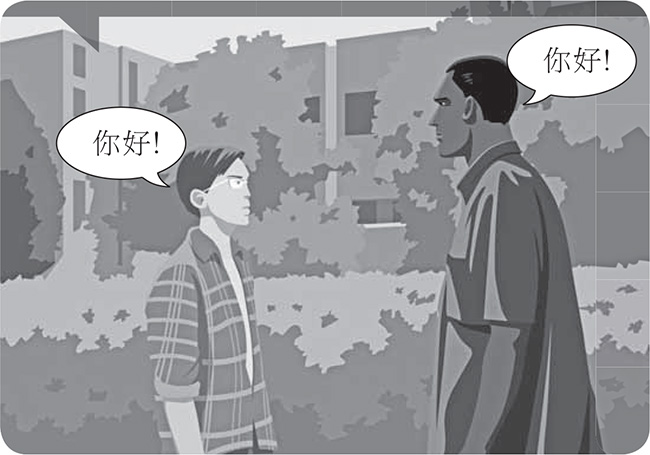
New Characters and Words 
Study the six characters below and the common words written with them, paying careful attention to each character’s pronunciation, meaning, and structure, as well as similar-looking characters. After you’ve studied a character, turn to the Practice Book volume and practice writing it on the practice sheet, making sure to follow the correct stroke order and direction as you pronounce it out loud and think of its meaning.
49 |
你 |
nĭ |
you |
Radical is 人 rén “person,” which is written 亻 when occurring at the left side of a character so as not to get in the way of the component to the right. The colloquial name for this radical is 人字旁 rénzìpáng “side made up of the character 人.” The other component of 你 is 尔 ĕr, which in Classical Chinese means “you.” |
|||
你 |
nĭ |
you [PR] |
|
50 |
好 |
hăo |
good |
Radical is 女 nǚ “woman” [BF]. This radical is referred to colloquially as 女字旁 nǚzìpáng “side made up of the character 女.” Note that when 女 is written at the left of a character as a radical, its last stroke is shortened so that it doesn’t collide with the component to its right. The other component of 好 is 子 zĭ “son” [BF]. The traditional explanation is that for a “woman” to be together with her “son” is “good.” |
|||
你好 |
nĭ hăo |
“how are you?,” “hi” [IE] |
|
51 |
我 |
wŏ |
I |
In this character, note that the radical, 戈 gē “dagger-axe” [BF], is on the right side. The whole character 我 consists of the verb 找 zhăo “look for” plus a small hat (the stroke 丿) at the very top of the character that represents “I” or “me.” The verb 找 in turn is composed of 扌 shŏu “hand” and 戈 gē “dagger-axe.” So the etymology of the whole character can be explained as using one’s “hand” to hold a “dagger-axe” to “look for” things (e.g., food or enemies) so as to ensure the survival of “me.” |
|||
我 |
wŏ |
I, me [PR] |
|
52 |
也 |
yĕ |
also |
Radical is 乙 yĭ “second of the ten Celestial Stems.” This character originated as a picture of an ancient drinking horn and was later borrowed to represent the pronunciation of the Chinese adverb that means “also.” Contrast 也 and 七 qī (8). |
|||
也 |
yĕ |
also, too [A] |
|
53 |
去 |
qù |
go |
The radical, at the bottom, is 厶 sī “private” [BF]. On top is the character 土 tŭ “earth.” Notice that the top horizontal line in 土 and 去 is shorter than the bottom horizontal line. |
|||
去 |
qù |
go, go to [V] |
|
54 |
呢 |
ne |
and what about |
Radical is 口 kŏu “mouth.” This radical is referred to colloquially as 口字旁 kŏuzìpáng “side made up of the character 口.” The addition of the radical 口 to a character indicates it has something to do with the mouth. Here, it indicates this is a particle used in speech. The other component of this character, 尼 ní, is the phonetic; by itself, it means “Buddhist nun” [BF]. |
|||
呢 |
ne |
and what about, and how about [P] |
|
我去,你呢? |
Wŏ qù, nĭ ne? |
I’m going, and what about you? |
|
New Words in BMC–SL 1-1 Written with Characters You Already Know 
王 |
Wáng |
Wang [SN] |
Reading Exercises (Simplified Characters) 
Now practice reading the new characters and words for this lesson in context in sentences, conversations, and narratives. Be sure to refer to the Notes at the end of this lesson, and make use of the accompanying audio disc to hear and practice correct pronunciation, phrasing, and intonation.
A. SENTENCES
Read out loud each of the following sentences, which include all the new characters of this lesson. The first time you read a sentence, focus special attention on the characters and words that are new to you, reminding yourself of their pronunciation and meaning. The second time, aim to comprehend the overall meaning of the sentence.
一、何大山,你好!文中生,你好!
二、我去山东,你去山西。
三、李小山去河北,王大文去河南。
四、你去南京,我也去南京,李大明也去南京。
五、去,去,去,去北京!
六、何台生去台北,王大明呢?
七、王京生去台山,林台生也去台山。
八、你去广东,我也去广东。
九、何大海,你去香港,我也去。
十、我去北京,王大海也去北京。
B. CONVERSATIONS
Read out loud the following conversations, including the name or role of the person speaking. If possible, find a partner or partners and each of you play a role. Then switch roles, so you get practice reading all of the lines.
一、
王京生:我去北京,也去香山。你呢?
文小山:我去天津。
二、
李中 :林生,你好!我去香港,你呢?
林生 :我去东京。文京明,你呢?
文京明 :我也去东京。
三、
李京生:北京好!
王台生:台北好!
何大海:北京好,台北也好。
C. CHARACTER DIFFERENTIATION DRILLS
Distinguish carefully the following similar-looking characters, pronouncing each one out loud and thinking of its meaning.
一、也 也 也 七 七 七
二、七 七 七 也 也 也
三、也 七 也 七 也 也 七
D. NARRATIVES
Read the following narratives, paying special attention to punctuation and overall structure. The first time you read a narrative, read it out loud; the second time, read silently and try to gradually increase your reading speed. Always think of the meaning of what you’re reading.
一、 |
何大海去西安,李中山也去西安。林文生去台中,也去台北。我去北京,也去上海。你呢? |
二、 |
文中去四川省成都市。李大山去广东省广州市。你呢? |
三、 |
王安湖去东京。东京好!金明去上海。上海也好。李京去香港,我也去香港。何小文,你呢? |
Reading Exercises (Traditional Characters) 
A. SENTENCES
Read out loud each of the following sentences, which include all the new characters of this lesson. The first time you read a sentence, focus special attention on the characters and words that are new to you, reminding yourself of their pronunciation and meaning. The second time, aim to comprehend the overall meaning of the sentence.
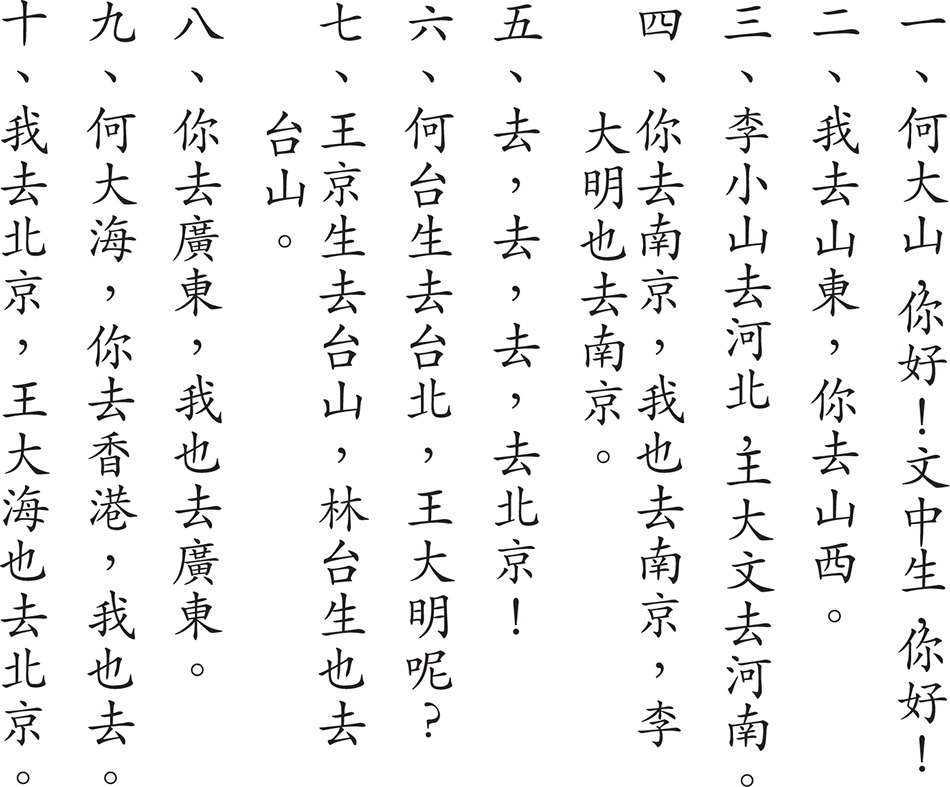
B. CONVERSATIONS
Read out loud the following conversations, including the name or role of the person speaking. If possible, find a partner or partners and each of you play a role. Then switch roles, so you get practice reading all of the lines.
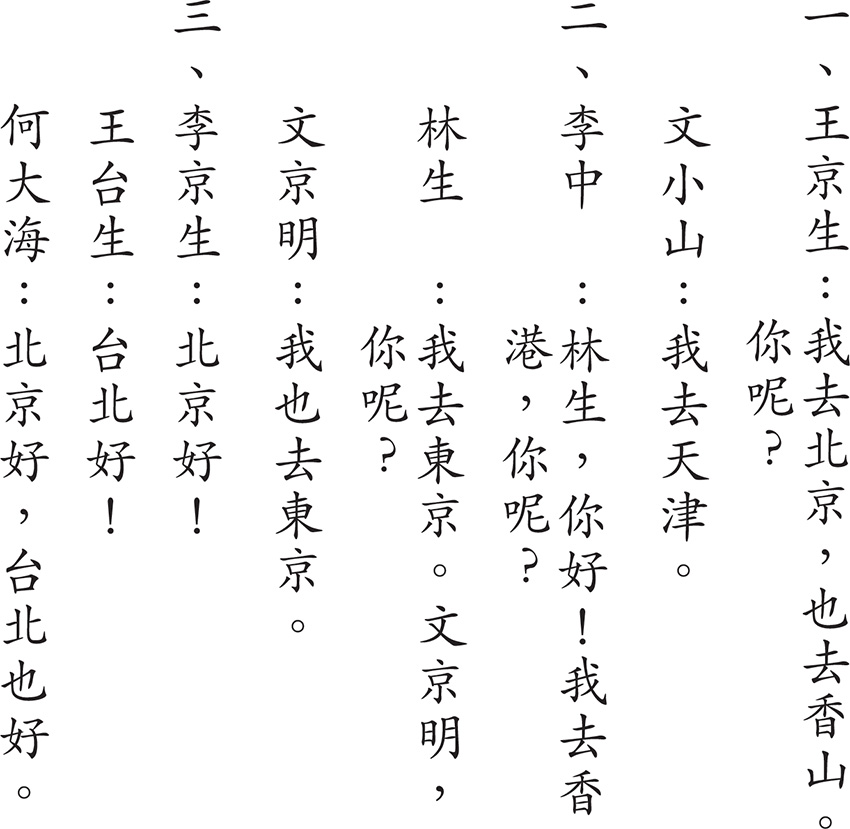
C. CHARACTER DIFFERENTIATION DRILLS
Distinguish carefully the following similar-looking characters, pronouncing each one out loud and thinking of its meaning.
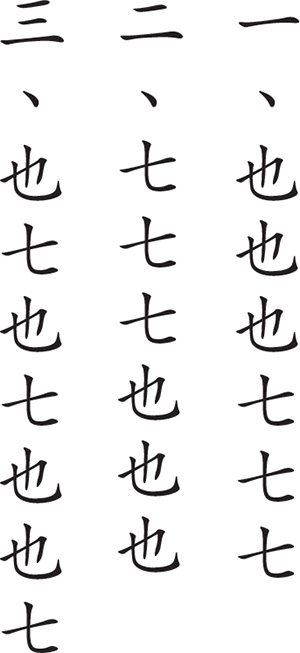

Typical street scene in Hong Kong
D. NARRATIVES
Read the following narratives, paying special attention to punctuation and overall structure. The first time you read a narrative, read it out loud; the second time, read silently and try to gradually increase your reading speed. Always think of the meaning of what you’re reading.
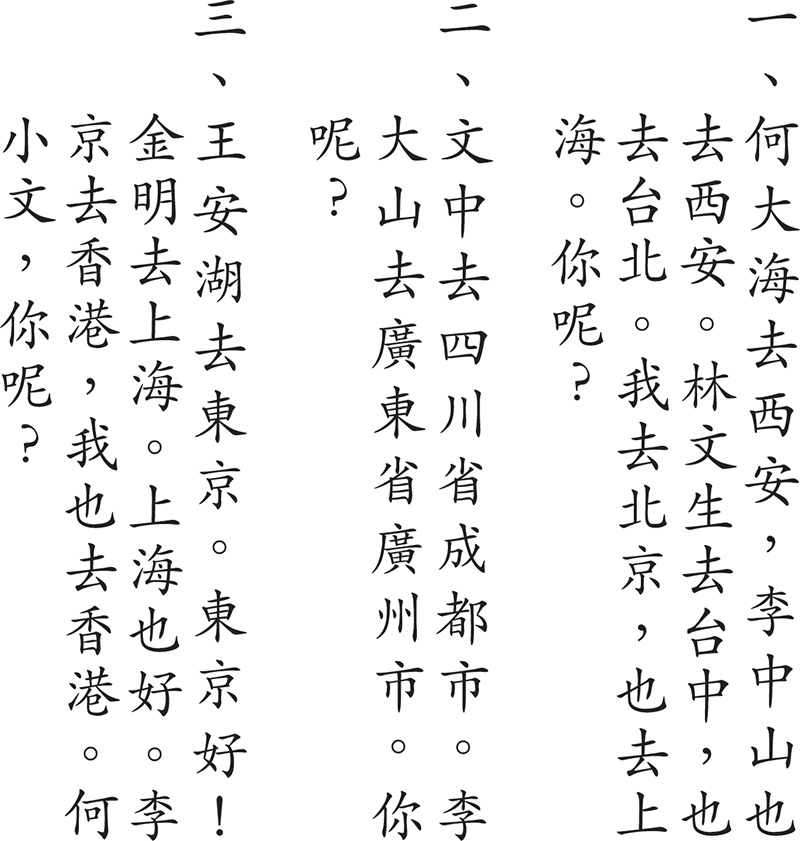
Notes
A1. The Chinese comma, called 逗号 (逗號) dòuhào (,), and the Chinese exclamation mark, called 叹号 (嘆號) tànhào (!), are often used as in English.
A2A. Take the clause 我去山东 (我去山東) Wŏ qù Shāndōng “I go to Shandong.” It clearly consists of three separate words: 我 + 去 + 山东 (山東), yet it’s written all together. As you’ve probably realized by now, the Chinese writing system does not leave spaces between words (except on rare occasions when a space before a word can indicate deep respect). This feature of the Chinese writing system explains why the average Chinese person has little concept of the “word.” Instead, he or she will typically speak of zì or “characters,” since these are the basic unit of the Chinese writing system.
A2B. Examine this sentence: 我去山东,你去山西 (我去山東,你去山西) “I go to Shandong; you go to Shanxi” or “I go to Shandong and you go to Shanxi.” Consider this translation strategy: a Chinese comma between two clauses is often best translated in English as a semicolon (;) or by the word “and.”
A2C. Notice the “Chinese period” at the end of this sentence. The Chinese period is called 句号 (句號) jùhào. Instead of a dot as in English, a Chinese period is a small circle, like this: 。 In horizontal writing, the Chinese period is placed to the bottom right of the last character of the sentence. In vertical writing, it is usually placed underneath the last character. In either case, it occupies the same amount of space as any other character.
A5. Verbs, such as the 去 in this sentence, are sometimes repeated for emphasis.
A6. Note the name 何台生. Where do you think this person, who has the surname 何, might have been born? (ANSWER: 台 could here stand for 台湾 (台灣), and 生 could mean “be born,” so 台生 could be an abbreviated way to indicate “born in Taiwan.”)
A7. Considering the information in the previous note, where do you think 王京生 was probably born?
A8. This sentence has two possible interpretations. In addition to “You go to Guangdong, and I also go to Guangdong,” it could also be interpreted as “If you go to Guangdong, then I will also go to Guangdong.” Although there are in Chinese explicit words for “if,” be aware that “if” must sometimes be inferred from the context and be supplied in the English translation. Sentence A9 is in this regard similar to sentence A8.
B1A. Notice the colon (:) after the speaker’s name. The Chinese word for colon is 冒号 (冒號) màohào. Chinese colons are used much as in English.
B1B. Notice the question mark (?) at the end of the first line. In Chinese, question marks are called 问号 (問號) wènhào. Chinese question marks are used much as in English (occasionally, Chinese question marks are used not only in direct questions but also in indirect questions, which is different from English).
B3. 好 here functions as a stative verb meaning “be good.” Thus, 北京好 means “Beijing is good” or “Beijing is better.” 台北好 works exactly the same way.
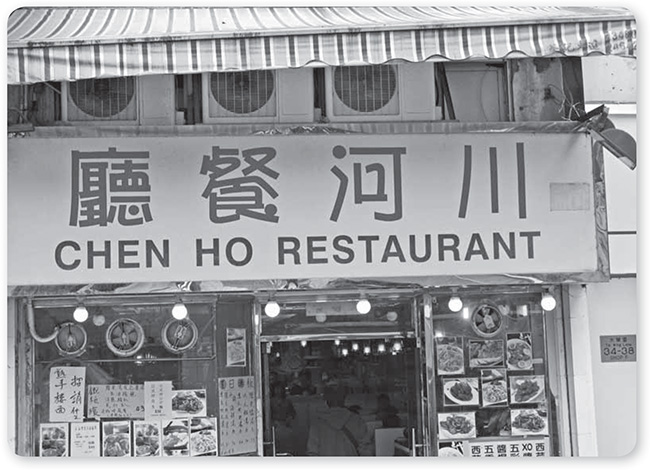
Hong Kong restaurant (characters read from right to left)